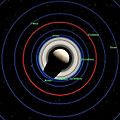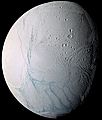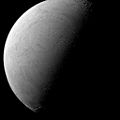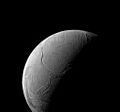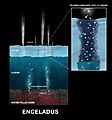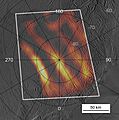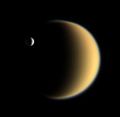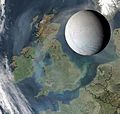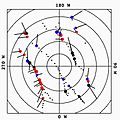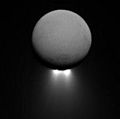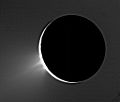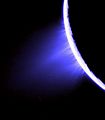Enceladus (moon) facts for kids
Enceladus is an amazing moon of Saturn. It's the sixth largest of Saturn's many moons, about 500 kilometers wide. Enceladus orbits inside Saturn's E ring, and it actually helps create this ring! The moon is mostly covered in water ice, which makes it super shiny. It reflects almost all the sunlight that hits it.
Discovering Enceladus

A long time ago, on August 28, 1789, a scientist named William Herschel discovered Enceladus. For many years, we knew little about this icy moon. But in 2014, NASA announced exciting news! Their Cassini spacecraft found strong clues that Enceladus has liquid water.
An Ocean World
Scientists now believe there's a huge underground ocean on Enceladus. This ocean is thought to be about 10 kilometers thick. It's located near the moon's south pole. Finding liquid water is a big deal because water is essential for life. This makes Enceladus a very interesting place to study!
Cold Volcanoes
Near Enceladus's south pole, there are special "cold volcanoes," also called cryovolcanoes. These aren't like Earth's hot lava volcanoes. Instead, they shoot out giant jets of water vapor and other gases. They also blast tiny particles of ice and even salt crystals into space. Some of these materials escape Enceladus and become part of Saturn's E ring. It's like the moon is constantly refilling the ring with its icy plumes!
Images for kids
-
View of Enceladus's Europa-like surface with the Labtayt Sulci fractures at center and the Ebony and Cufa dorsa at lower left, imaged by Cassini on February 17, 2005
-
Enceladus transiting the moon Titan
-
A size comparison of Enceladus against the British Isles.
See also
 In Spanish: Encélado (satélite) para niños
In Spanish: Encélado (satélite) para niños


